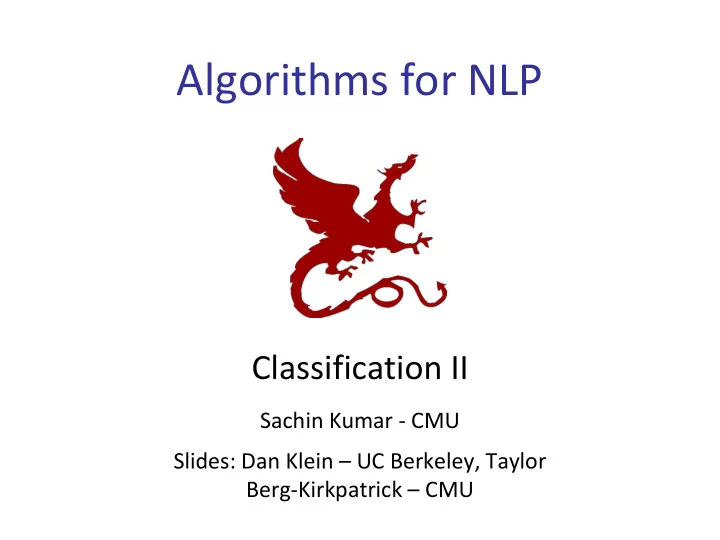

Algorithms for NLP Classification II Sachin Kumar - CMU Slides: Dan Klein – UC Berkeley, Taylor Berg-Kirkpatrick – CMU
Parsing as Classification ● Input: Sentence X ● Output: Parse Y ● Potentially millions of candidates x y The screen was a sea of red
Generative Model for Parsing ● PCFG: Model joint probability P(S, Y) ● Many advantages ○ Learning is often clean and analytical: count and divide ● Disadvantages? ○ Rigid independence assumption ○ Lack of sensitivity to lexical information ○ Lack of sensitivity to structural frequencies
Lack of sensitivity to lexical information
Lack of sensitivity to structural frequencies: Coordination Ambiguity
Lack of sensitivity to structural frequencies: Close attachment
Discriminative Model for Parsing ● Directly estimate the score of y given X ● Distribution Free: Minimize expected los ● Advantages? ○ We get more freedom in defining features - ■ no independence assumptions required
Example: Right branching
Example: Complex Features
How to train? ● Minimize training error? ○ Loss function for each example i 0 when the label is correct, 1 otherwise ● Training Error to minimize
Objective Function 1 ● step function returns 1 when argument is negative, 0 otherwise ● Difficult to optimize, zero gradients 0 everywhere. ● Solution: Optimize differentiable upper bounds of this function: MaxEnt or SVM
Linear Models: Perceptron ▪ The (online) perceptron algorithm: ▪ Start with zero weights w ▪ Visit training instances one by one ▪ Try to classify ▪ If correct, no change! ▪ If wrong: adjust weights
Linear Models: Maximum Entropy ▪ Maximum entropy (logistic regression) ▪ Convert scores to probabilities: Make positive Normalize ▪ Maximize the (log) conditional likelihood of training data
Maximum Entropy II ▪ Regularization (smoothing)
Log-Loss ▪ This minimizes the “log loss” on each example ▪ log loss is an upper bound on zero-one loss
How to update weights: Gradient Descent
Gradient Descent: MaxEnt ● what do we need to compute the gradients? ○ Log normalizer ○ Expected feature counts
Maximum Margin Linearly Separable
Maximum Margin ▪ Non-separable SVMs ▪ Add slack to the constraints ▪ Make objective pay (linearly) for slack:
Primal SVM ▪ We had a constrained minimization ▪ … but we can solve for ξ i ▪ Giving: the hinge loss
How to update weights with hinge loss? ● Not differentiable everywhere ● Use sub-gradients instead
Loss Functions: Comparison ▪ Zero-One Loss ▪ Hinge ▪ Log
Structured Margin Just need efficient loss-augmented decode: Still use general subgradient descent methods!
Duals and Kernels
Nearest Neighbor Classification
Non-Parametric Classification
A Tale of Two Approaches...
Perceptron, Again
Perceptron Weights
Dual Perceptron
Dual/Kernelized Perceptron
Issues with Dual Perceptron
Kernels: Who cares?
Example: Kernels ▪ Quadratic kernels
Non-Linear Separators ▪ Another view: kernels map an original feature space to some higher-dimensional feature space where the training set is (more) separable Φ: y → φ ( y )
Why Kernels? ▪ Can’t you just add these features on your own (e.g. add all pairs of features instead of using the quadratic kernel)? ▪ Yes, in principle, just compute them ▪ No need to modify any algorithms ▪ But, number of features can get large (or infinite) ▪ Some kernels not as usefully thought of in their expanded representation, e.g. RBF or data-defined kernels [Henderson and Titov 05] ▪ Kernels let us compute with these features implicitly ▪ Example: implicit dot product in quadratic kernel takes much less space and time per dot product ▪ Of course, there’s the cost for using the pure dual algorithms …
Tree Kernels
Dual Formulation of SVM
Dual Formulation II
Dual Formulation III
Back to Learning SVMs
What are these alphas?
Comparison
Reranking
Training the reranker ▪ Training Data: ▪ Generate candidate parses for each x ▪ Loss function:
Baseline and Oracle Results Collins Model 2
Experiment 1: Only “old” features
Right Branching Bias
Other Features ▪ Heaviness ▪ What is the span of a rule ▪ Neighbors of a span ▪ Span shape ▪ Ngram Features ▪ Probability of the parse tree ▪ ...
Results with all the features
Reranking ▪ Advantages: ▪ Directly reduce to non-structured case ▪ No locality restriction on features ▪ Disadvantages: ▪ Stuck with errors of baseline parser ▪ Baseline system must produce n-best lists ▪ But, feedback is possible [McCloskey, Charniak, Johnson 2006] ▪ But, a reranker (almost) never performs worse than a generative parser, and in practice performs substantially better.
Summary ● Generative parsing has many disadvantages ○ Independence assumptions ○ Difficult to express certain features without making grammar too large or parsing too complex ● Discriminative Parsing allows to add complex features while still being easy to train ● Candidate set for discriminative parsing is too large: Use reranking instead
Another Application of Reranking: Information Retrieval
Modern Reranking Methods
Learn features using neural networks Replace by a neural network
Reranking for code generation
Reranking for code generation (2) ● Matching features
Reranking for semantic parsing
Recommend
More recommend